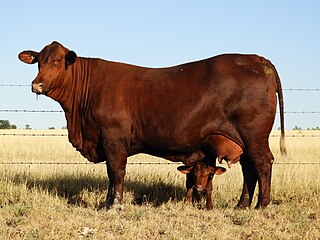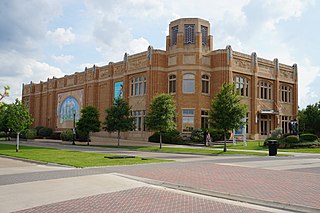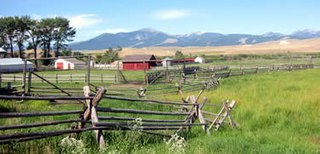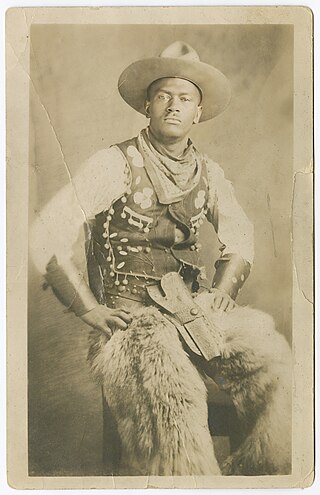Related Research Articles

The Texas Longhorn is an American breed of beef cattle, characterized by its long horns, which can span more than 8 ft (2.4 m) from tip to tip. It derives from cattle brought from the Iberian Peninsula to the Americas by Spanish conquistadores from the time of the Second Voyage of Christopher Columbus until about 1512. For hundreds of years the cattle lived a semi-feral existence on the rangelands; they have a higher tolerance of heat and drought than most European breeds. It can be of any color or mix of colors. In some 40% of the cattle it is some shade of red, often a light red; the only shade of red not seen is the deep color typical of the Hereford.

A cowboy is an animal herder who tends cattle on ranches in North America, traditionally on horseback, and often performs a multitude of other ranch-related tasks. The historic American cowboy of the late 19th century arose from the vaquero traditions of northern Mexico and became a figure of special significance and legend. A subtype, called a wrangler, specifically tends the horses used to work cattle. In addition to ranch work, some cowboys work for or participate in rodeos. Cowgirls, first defined as such in the late 19th century, had a less-well documented historical role, but in the modern world work at identical tasks and have obtained considerable respect for their achievements. Cattle handlers in many other parts of the world, particularly South America and stockmen and jackaroos in Australia, perform work similar to the cowboy.

Mary Temple Grandin is an American academic and animal behaviorist. She is a prominent proponent for the humane treatment of livestock for slaughter and the author of more than 60 scientific papers on animal behavior. Grandin is a consultant to the livestock industry, where she offers advice on animal behavior, and is also an autism spokesperson.

The Brahman is an American breed of zebuine-taurine hybrid beef cattle. It was bred in the United States from 1885 from cattle originating in India, imported at various times from the United Kingdom, from India and from Brazil. These were mainly Gir, Guzerá and Nelore stock, with some Indu-Brasil, Krishna Valley and Ongole. The Brahman has a high tolerance of heat, sunlight and humidity, and good resistance to parasites. It has been exported to many countries, particularly in the tropics; in Australia it is the most numerous breed of cattle. It has been used in the creation of numerous taurine-indicine hybrids, some of which – such as the Brangus and Brahmousin – are established as separate breeds.

The Santa Gertrudis is an American breed of beef cattle. It is a taurine-indicine hybrid breed, descended from both zebu and European cattle. It was bred in the early twentieth century in Texas, and received official recognition in 1940. It has been exported to many countries including Australia, Brazil and South Africa, and has contributed to the development of a number of modern breeds, among them the Barzona and the Droughtmaster.

The National Cowgirl Museum and Hall of Fame is located in Fort Worth, Texas, US. Established in 1975, it is dedicated to honoring women of the American West who have displayed extraordinary courage and pioneering fortitude. The museum is an educational resource with exhibits, a research library, and rare photography collection. It adds Honorees to its Hall of Fame annually.

Cattle drives were a major economic activity in the 19th and early 20th century American West, particularly between 1850s and 1910s. In this period, 27 million cattle were driven from Texas to railheads in Kansas, for shipment to stockyards in Louisiana and points east. The long distances covered, the need for periodic rests by riders and animals, and the establishment of railheads led to the development of "cow towns" across the frontier.
History of rodeo tracks the lineage of modern Western rodeo.

The Fort Worth Stock Show & Rodeo is the oldest continuously running livestock show and rodeo. It has been held annually in Fort Worth, Texas since 1896, traditionally in mid-January through early February. A non-profit organization, the Stock Show has provided millions of dollars in grants and scholarships in its tenure and continues to provide hundreds of thousands of dollars annually to assist the future leaders of agriculture and livestock management.

A ranch is an area of land, including various structures, given primarily to ranching, the practice of raising grazing livestock such as cattle and sheep. It is a subtype of farm. These terms are most often applied to livestock-raising operations in Mexico, the Western United States and Western Canada, though there are ranches in other areas. People who own or operate a ranch are called ranchers, cattlemen, or stockgrowers. Ranching is also a method used to raise less common livestock such as horses, elk, American bison, ostrich, emu, and alpaca.

Fern Sawyer was an American cowgirl, rodeo champion, politician and inductee into the National Cowgirl Museum and Hall of Fame and the Rodeo Hall of Fame of the National Cowboy and Western Heritage Museum. She was the first woman to win the cutting horse competition at the 1945 Fort Worth Fat Stock Show and Rodeo. Sawyer was also the first woman appointed to the New Mexico State Fair Board. She was well known for her "flashy attire," according to the Santa Fe New Mexican. She lived in Crossroads, Lovington, and Nogal, New Mexico. She was also a charter member of the National Cutting Horse Association and the first director of the Girls Rodeo Association.
Mollie Taylor Stevenson Scott, a former model, is the daughter of Benjamin Franklin "Big Ben" Stevenson and Mollie Stevenson (1911-2003). Mollie Jr. and her mother were the first living African-American women inducted into the National Cowgirl Museum and Hall of Fame. She and her husband, Elicious Scott Jr., taught and connected children and adults with Western culture and agriculture.

Black cowboys in the American West accounted for up to an estimated 25% of cowboys "who went up the trail" from the 1860s to 1880s and substantial but unknown percentage in the rest of the ranching industry, estimated to be at least 5,000 workers according to recent research.

Frances ElaineRosenthalKallison was a pioneering American rancher, historian, and philanthropist. In 2016, she became the first Jewish woman inducted into the National Cowgirl Hall of Fame in recognition of her courage, resilience and independence.
Mary Ann Dyer "Molly" Goodnight was an American cattlewoman and rancher married to prominent Texas rancher and cattleman Charles Goodnight. She was a 1991 inductee of the National Cowgirl Museum and Hall of Fame.
Jo Ann Smith was inducted into the National Cowgirl Museum and Hall of Fame in 2015. She is the first woman to become the president of the National Cattlemen's Beef Association.
Pam Minick was inducted into the National Cowgirl Museum and Hall of Fame in 2000.
Linda Mitchell Davis was inducted into the National Cowgirl Museum and Hall of Fame in 1995.
Thena Mae Farr, is a 1985 National Cowgirl Museum and Hall of Fame inductee.
Sallie Reynolds Matthews is a 1982 National Cowgirl Museum and Hall of Fame inductee. She was a pioneer in Texas who wrote a book chronicling her families.
References
- 1 2 "Minnie Lou Bradley". Cowgirl Hall of Fame & Museum. Retrieved October 18, 2019.
- 1 2 3 4 "Minnie Lou Bradley". Texas History Notebook. March 7, 2019. Retrieved October 18, 2019.
- ↑ "Meet 86-Year-Old Rancher Minnie Lou Bradley". Garden & Gun. July 9, 2018. Retrieved October 18, 2019.
- ↑ "Division of Agricultural Sciences and Natural Resources". Oklahoma State alumna Minnie Lou Bradley receives highest national honor. Retrieved October 18, 2019.
- ↑ "At Home On The Range With Minnie Lou Bradley". COWGIRL Magazine. June 19, 2017. Retrieved October 18, 2019.
- ↑ "Minnie Lou Bradley: The story behind the iconic trailblazer". Beef Magazine. September 19, 2018. Retrieved October 18, 2019.